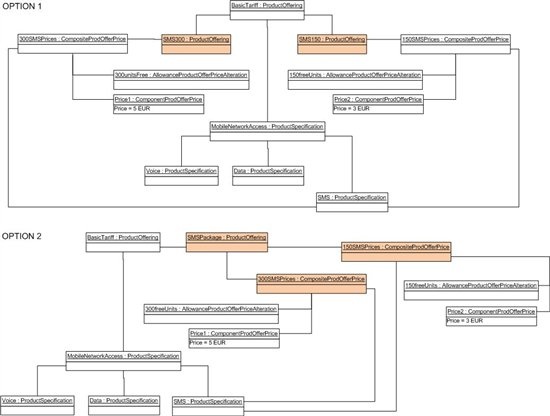Created by Unknown User ([email protected])
This nugget provides some comprehensive explainations and real world modelling example to help understanding the ProductOffering and ProductOfferingPrice entities in SID and their associations to ProductSpecification.
General
To make it easier to understand the examples, this paragraph provides short descriptions and comprehensive examples of the relevant entities (summarized from the product addendum).
Product Specification
A ProductSpecification is a detailed description of a perceivable piece of functionality that can be made available (but doesn’t need to be) by one or many ProductOfferings. A ProductSpecification may be a collection of other ProductSpecification.
Examples: Functional description of NetworkAccess, Mailbox, equipment.
ProductOffering
A ProductOffering is a detailed description of the commercial conditions for an offer for sale, rental or lease. A ProductOffering may (a) market (exactly) one ProductSpecification, (b) be bundled within a BundledProductOffering or (c) is a bundle of other ProductOfferings. These options are not exclusive.
Examples: Tariff for using a network access, Tariff option for using a network access, equipment offer
Free usage packages as additional options to a basic tariff
Often it is required to model packages for free usage of functionality (e.g. “500 free text messages” or “300 free voice minutes”) – usually without adding any new functionality to an offer. Consequently there is no additional ProductSpecification needed to model that.
A free unit package can be modeled as a ProductOffering, without an association to a ProductSpecification, which is bundled into the basic ProductOffering.
A CompositeProductOfferPrice, associated with that ProductOffering, should be used to model the recurring charge for the package and the free units as an allowance.
If different amounts of units shall be offered to the customer two options are valid:
- Modeling separate ProductOfferings for each
- Modeling one ProductOffering with multiple CompositeProductOfferingPrices – one for each amount of free units. Additional rules are necessary for this option to force the customer to choose exactly one of these prices
However the CompositeProductOfferPrice must be associated with the ProductSpecification for which the free units are to be applied.
An example of both option are outlines in the figure below.
Unfortunately a ProductOffering is not an entity the entity-characteristic pattern can be applied for. Accordingly it is not possible to parameterize ProductOfferings, for modeling the different amounts and associate the prices to the distinct characteristic values (maybe a CR should be considered for that).
Associations between ProductOffering and ProductSpecification
As mentioned above, free units usually are not adding any functionality to an existing ProductSpecification, so they are not associated with a ProductSpecification. As a consequence of this, as an AtomicProductOfferings (see diagrams above) without an associated ProductSpecification, that modeling approach would contradict to the statement made in GB922 addendum Product page 18 figure 5b.
A resolution of that would be to add an additional association for the AtomicProductOffering to the ProductSpec the price is associated to (SMS ProductSpec in this example).
